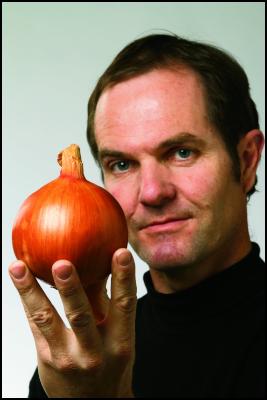How sweet is your onion?
7th September 2006
How sweet is your
onion?

A single gene has been identified as critical to both the sweetness and storability of onions.
In collaboration with international colleagues, Crop & Food Research vegetable geneticist John McCallum has been able to identify that a gene, Frc on chromosome 8, is responsible for sugar content in onions.
It’s a discovery that could have significant implications for onion growers the world over.
“The information could make it possible in the future to consistently produce sweet-eating or better-storing onions,” Dr McCallum says. “Given that onions currently vary widely in terms of bulb size, taste and processing qualities, this research is likely to be highly sought-after by growers interested in consistent characteristics.”
Dr McCallum says there is a relationship between sweetness and dry matter level, which is important for onion storability. The more frequently the sweetness gene occurs, the sweeter the onion. The less often it occurs, the less sweet, but the harder the onion is, making it good for storage or export. This has implications for New Zealand’s economy as onions are a significant export crop.
“This has been a good characteristic to work with because of its implications for the onion market,” says Dr McCallum.
He says the major application of the science will be to help conventional onion breeders more rapidly and accurately select varieties with consistent sweetness or storability traits.
The research, which took five years, was funded by the Foundation for Research, Science and Technology. International collaboration with researchers in Japan, the Netherlands and the USA allowed access to plant and genome data that helped clinch the story.
A significant science story:
“This research is one of the first major practical applications of the onion gene map,” Dr McCallum says.
“We began by crossing a sweet onion with a non-sweet onion and evaluating inherited carbohydrate composition in the progeny. This research threw up the negative correlation between sweetness and dry matter levels, suggesting the action of a major gene. The fact that we had the onion gene map, meant that once we had found a significant genetic marker that we could link to the correlation, our work progressed rapidly. We were quite simply able to use the onion gene map to confirm that a major gene in the same genome region was the main determinant of sweetness in all these populations.”
For further contact details and more
interesting facts about onions…see page 2.
Onion Facts
The ancient Egyptians, and many civilisations since, valued onions not only as a food but as a medicine. Modern medical science has confirmed these beliefs, showing that the fructan, flavonoid and sulfur compounds combine to make onion a truly functional (healthy) food. Fructans for instance, enhance the value of the onion by conferring prebiotic properties and lowering blood lipid and insulin levels.
Onion is one of the most valuable vegetable crops in the world.
In 2005, the New Zealand export onion crop was worth $61.6 million.
The onion has an extremely large genome size, 36 times that of rice, which complicates application of key molecular technologies when studying this vegetable.
Sweet onions feel softer and have thicker scales than storage onions
From a flavour point of view, red onions are just the same as brown onions.
ENDS


 The Document Foundation: Celebrating 20 Years Of The OASIS Open Document Format (ODF) Standard
The Document Foundation: Celebrating 20 Years Of The OASIS Open Document Format (ODF) Standard Maritime Union of New Zealand: Maritime Union Raises Serious Concerns Over Aratere Ferry Removal
Maritime Union of New Zealand: Maritime Union Raises Serious Concerns Over Aratere Ferry Removal Ferry Holdings Limited: Decommissioning Of The Aratere Ferry
Ferry Holdings Limited: Decommissioning Of The Aratere Ferry Broadcasting Standards Authority: Inaccurate 1News Reporting On Football Violence Breached Broadcasting Standards
Broadcasting Standards Authority: Inaccurate 1News Reporting On Football Violence Breached Broadcasting Standards Better Taxes for a Better Future: $1b Cut In Budget Operating Allowance ‘Unnecessary And Damaging’
Better Taxes for a Better Future: $1b Cut In Budget Operating Allowance ‘Unnecessary And Damaging’ Transport Well NZ: Transport Well New Zealand Charitable Trust - A Vision For The Entire Sector
Transport Well NZ: Transport Well New Zealand Charitable Trust - A Vision For The Entire Sector